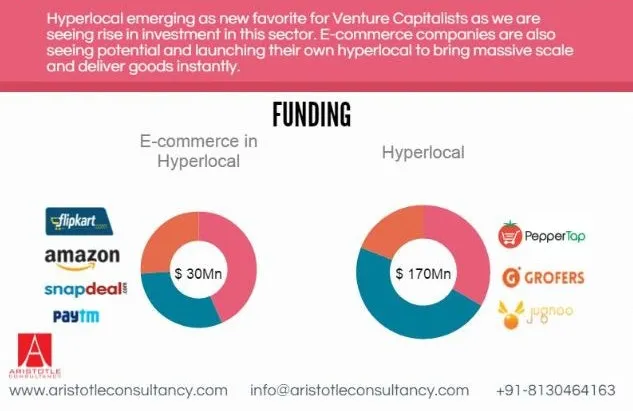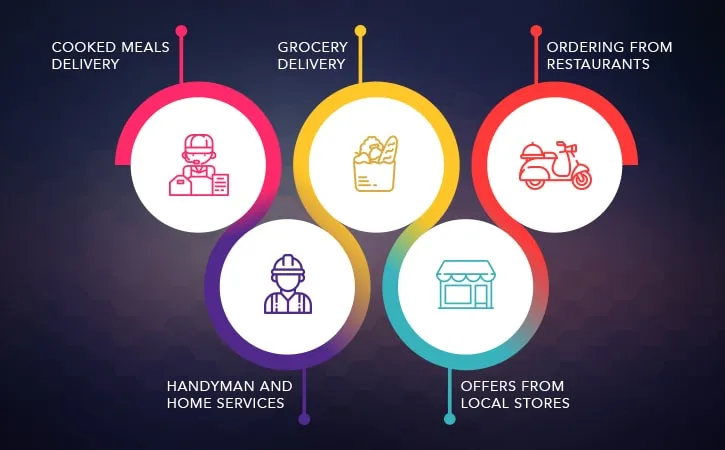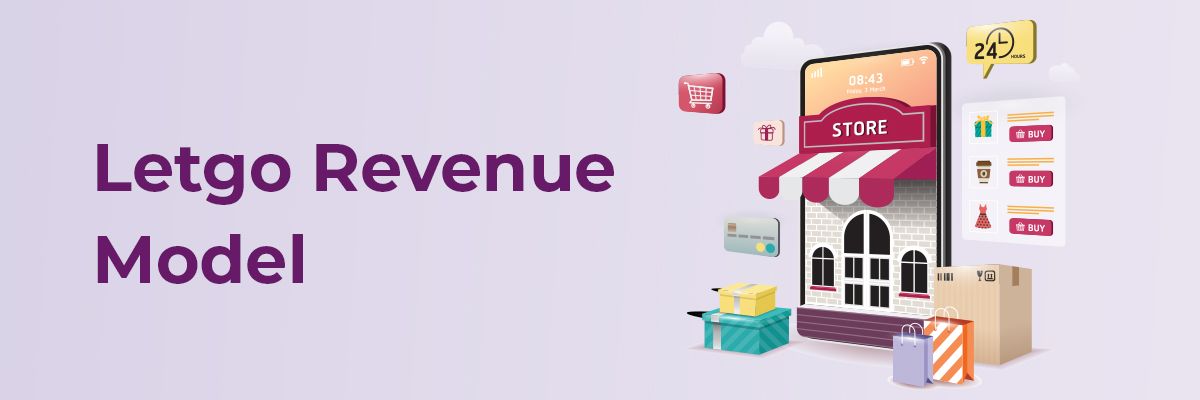

Challenges and Opportunities of Hyperlocal eCommerce in India

Challenges and opportunities
spreading its root in the eCommerce world with an adroit speed, Hyperlocal has become the rumble of the mob in a wink.
Stirring up the curiosity and interest of huge chunk of entrepreneurs who were on tenterhooks for something that can make them stand out, hyperlocal eCommerce has served the purpose.

Hyperlocal
Source: aristotleconsultancy.com
In line with the data of aristotleconsultancy.com hyperlocal startups are looping in more fund in comparison to other B2C markets. Hyperlocal eCommerce industry has become the new favourite segment of venture for capitalists.
Bunch of entrepreneurs have managed to batten their position in the gigantic eCommerce realm by fusing their ideas with the concept of hyperlocal.
Before delving deeper into the challenges and opportunities of hyperlocal eCommerce let’s cast a glance at what hyperlocal is.
What is Hyperlocal?
The meaning of hyperlocal is something (community, organisation, service etc.) that is confined to a certain geographical area.
The basic principle on which the concept of hyperlocal works on are geography and time.
The term was coined in 1991 and in due course of time, it has been through many phases, out of which the most recent is GPS based services and mobile apps.
With an upsurge in technology, the current of hyperlocalism has covered almost all the possible streams. Like-
Food Delivery

Food delivery model
Source: peerbits.com
In India, food delivery services became a craze when Domino's and Pizza Hut started their delivery services. To keep themselves from getting knocked out the competition, several food-chains started providing home delivery services as well.
By 2014 a new stream of food delivery services emerged. With the launch of Swiggy, Zomato, and, Ubereats, and Foodpanda etc. in India, all the food-chains and restaurants got a fair chance to propel themselves.
These food delivery services provide the restaurants with a platform for listing their food and delivery men for picking and delivering the orders in lieu of registration and service charges.
Swiggy, India’s very own food delivery service is an example of how fast the hyperlocal space have etched into every commoner’s life. Emerging as a small startup in Bangalore in 2014 now it has branched all over India.
According to a Livemint Report , Swiggy has been termed as “India’s fastest unicorn.” At the beginning when Swiggy was considered as a late entry in the eCommerce industry as it was considered that not much was left to be covered plus online food delivery was not seen as a very tempting business option.
Swiggy proved that there is so much left to be achieved in the hyperlocal business.
Grocery Stores

Popularity chart of Online Grocery Store
Big basket, Grofers etc. are sundry online grocery stores that have blossomed out well.
Bigbasket kick-started in 2011 subsequent to when the founders reuniting after selling their physical grocery-store chain ‘Fabmart’ to Aditya Birla group.
They have been since heightening the benchmark in the field with their exquisite services.
Presently the net worth of BigBasket is approximately 1800cr
Superseding the footsteps of Bigbasket, Grofers too stepped in the market in 2013 and is excelling since then.
Hyperlocal electronic market
According to a crunchbase report “Zopper.com is India's largest hyperlocal mobile marketplace featuring over 15,000+ offline retailers. ” Operating in 100+ cities.
Zopper emanates itself as a sterling illustration of what the Hyperlocal market in India can offer if uniqueness is infused in the business ideas.
Hyperlocal Services
Delivering almost all kind of home services like home maintenance, beauty services, preparation of celebrations and much more. Urbanclap is the hyperlocal platform for supplying services at the doorsteps of the consumers.
Probing into the Indian Hyperlocal marketplace in 2014, Urbanclap almost immediately became a favourite to the commoners. Their strategy of seeping in the metro cities at primary stage have provided Urbanclap with a great boost.
Metro cities have people with the busiest life-schedule. As a hyperlocal service providing marketplace Urbanclap has proved to be a boon for the population residing in these cities. They don’t have to particularly mull out their phone directories for the service numbers. Every service is available just at a few clicks.
In a Livemint report it has been stated that the revenue of 2017 stood around 7 crores and by April 2018 an additional revenue collection of 1.5 crores.
Hyperlocal eCommerce Challenges in India
Though hyperlocals in India have enrooted themselves firmly, they had faced several marketplace challenges. Some of them tackled them wittingly and steered clear while others were just overturned within a short time period.
So what are the challenges they faced?
Frankly speaking, the nature and size of your problem totally depend majorly upon the size of your business and your area of operation.
- Area of operation
Starting in the cities that are still not tech-rigged and major part of the population is not used to buying things online, naturally can’t be the primary choice for a hyperlocal startup
- Brick and mortar stores
Reasonably people grow more sceptical when it comes to items with a shorter shelf life. Rather than taking a chance and buying them online they densely hinge on taking some time and buying them from brick and mortar stores themselves. Especially vegetable, fruits and other food items like meat, fish, dairy products etc.
Major population buy groceries themselves rather than ordering them online, especially in the third tier cities.
- Cut-throat competition
Not only the other well-established hyperlocals but the big eCommerce that are desperately trying to flap their wings open in order to fly high in this sphere with all guns blazing.
These pioneers are sure to have a strong ground-hold as they are already entrenched. Forming Tie-ups with local vendors would be much easier for them than a new startup. Reason, vendors would naturally like to associate themselves with a bigger and better brand to get a fair chance to increase their sales.
These reasons aside, myriad hyperlocal startups commit gaffes that eventually uproot them. Their own blunders cause their downfall and we are deliberating a few akin cases here
What Went Wrong With These Startups
Setting up a hyperlocal platform in India and making it a roof-breaker is onerous.
Where there are numerous archetypes of successful startups that have developed a firm grip on the eCommerce market, there are also examples of such startups that toppled in a short period of time even though their introduction to the market was grand.
Let’s see what went wrong with them.
Ola Cafe & Ola Store
Most of you must be unaware that Ola, the India originated cab aggregator, started hyperlocal online food and grocery delivery services in June 2015 in Gurgaon, Bangalore and Hyderabad.
As quick as its opening was, so was the layoff. Within 10 months the service was shut down.
Though according to a report of livemint the business scaled for first 3 or 4 months but then went into dumps as it couldn’t meet the demands.
Ultimately they have to shut their service down by March 2nd 2016.
The service was somewhat like Swiggy.
Ola Exhibited some distinct platter from a few restaurants in the geographical umbrella of the customer, instead of providing with the elaborated menu. Ola driver bought the dishes beforehand and delivered them when someone ordered.
Ola stepped on this path following Uber as it launched its food delivery service in Los Angeles in 2014.
Reasons for failure
- The management charges were disproportionate to the order value yielding very low margin.
- It faced tough competition from startups like Grofers, Swiggy etc.
- They didn’t have a proper plan to disperse the resources accordingly.
Solution
It is totally clear that the management of resources was not as it was supposed to be.
First of all, Ola should have totally put up a different operating segment dedicated to food and grocery delivery. The cab drivers being the delivery men as well, would definitely have started causing tumult at some point.
Supposedly they were in the middle of a passenger ride and someone placed an order for food or grocery item or vice-versa, they couldn’t have just abandoned their current task to fulfil the later one. Sooner or later, the excess time being taken would have put the customers off and they would have started losing customers from every sphere eventually causing a huge catastrophe.
Secondly, The drivers buying the dishes beforehand and delivering them when an order was placed, this method would have eventually pulled them into a loss. The reason, buying stuff beforehand without knowing whether an order will be placed or not is a plain wastage of capital especially in those cases where the shelf life of the product is only for a limited time period.
PepperTap
Being a dedicated hyperlocal grocery store the future for PepperTap seemed to be bright and blooming as they were initially thriving.
Opting for an inventory less model
By 2015 they had expanded in around 31 cities. Peppertap was making more than 20000 deliveries daily, which from a layman’s gimmick is pretty good. Founded in November 2014 they had to herald their gridlock within 17 months. What went wrong?
Reasons for failure
- The business model of PepperTap was unviable. In the thrill of the startup, they totally overlooked the margin they were earning.
Exaggerated marketing and de trop discount with a nominal margin were sucking out all the venture capital instead of reaping any revenue out of the startup.
They were losing approximately Rs. 200/ order. Given that their sales were around 20,000 per day the loss was 40,00,000 INR or around 60,000 USD at that time.
- They centralized a huge chunk of their equity on their existing customers through overwhelming discounts as discussed earlier while averting their focus from the technology they were using. Their assimilation with their partner stores on the app was not proper at all.
- Lastly, they expanded way more than their dexterity within a narrow time window without proper planning. As a result, they had to pull plugs from many cities including metro cities leading to retrenchment of employees in abundance. This step deteriorated the company’s reputation in a wink.
Solution
PepperTap should have focused on their app integration primarily before mindlessly blowing their equity. Needless to say, the website and app of an eCommerce business is its backbone. If that is not strong and well-working then the business is bound to crash.
Burning nearly all the Venture capital in extravagant marketing and redundant discounts was not at all a wise decision.
Finally expanding nimbly without any solid plan and base then retreating even faster plus downturning the number of employees was a decision that certainly couldn’t have favoured the company and its goodwill.
Same was the case of TinyOwl and LazyLad.
Flipkart ‘Nearby’
On contrary to what I have mentioned earlier about established eCommerce companies getting a solid foothold in hyperlocal, Flipkart grocery had to pull the plug of its hyperlocal app ‘Nearby’ within 5 months.
Miming the principle of Amazon pantry, Flipkart initiated ‘Nearby’ in Bangalore on trial basis. The closure of Nearby itself indicates it couldn’t take off as well as Amazon Pantry, hence shutdown.
Reasons for failure
- They didn’t provide ‘Nearby’ a proper runway to takeoff i.e they didn’t take any initiative for its promotion. Finally, due to poor customer demand and nominal margin, they had to shut down ‘Nearby.’
Solution
‘Nearby’ had a lot of potentials but Flipkart didn’t take it seriously, to begin with.
Flipkart could have opted for social media marketing to pint up ‘Nearby.’ it could have taken after the strategies of Bigbasket but they didn’t bother with that.
Opportunities for Hyperlocal Marketplace in India
Enabling hyperlocal commerce in India however has a lucrative prospect.
People are still majorly in favour of buying food and groceries from brick and mortar shops, however, they are willing to give hyperlocal e-stores a chance, because who wouldn’t want the luxury of doorstep delivery.
Secondly, the hyperlocal entrepreneurs with niche ideas have embarked themselves ad hoc. Few of them already mentioned earlier e.g BigBasket, Zopper, UrbanClap etc.
No matter how popular the B2C eCommerce companies like Amazon, eBay, Flipkart, Snapdeal etc. are, they can’t deliver electronics in just a few hours if talk about their services in India. Zopper loomed in this opportunity and established its hyperlocal marketplace.
Already being an expert in the field of physical grocery chain stores, the previous owners of Fabmart thought to shift online and established BigBasket whom Amazon had been trying to take over allegedly but haven’t succeeded yet.
Imagine you don’t have to run here and there to find someone to do the odd jobs and every contact is just one click away from you. That’s what UrbanClap did.
All three of these hyperlocal eCommerce businesses are poles apart when it comes to the forte of product and services. But they have caught the pulses of the customers in the right manner and made their way through the mob of entrepreneurs to etch their places in the eCommerce world.
Things to Remember
Before you start, keep these pointers in mind
Do your Homework
Observe the ongoing hyperlocal marketplace trends, then compare how well they are doing in the place where you want to put your startup.
Conduct a comprehensive survey regarding what general people would like plus how fulfilling the present hyperlocal services are.
It will also help you get an idea about your competitors as in where they stand, what they lack and how strong rivals they will prove to be. Prior to singling out your forte, this survey will help you decide in which hyperlocal sector you should make your investment as well.
Niche Ideas Are Always Unbeaten
eCommerce world always spins on the fingers of innovators. Be a trendsetter in the world of eCommerce and your name will be ingrained as a successful entrepreneur who made a difference. Those who follow the crowd get lost in it if we talk about startups in eCommerce.
Through your survey and observation, you will be able to fuse your contemporary concepts and by the time the crowd will turn to follow you, you will already be leading it.
Plan Your Investments
A lot of segments in your business will need investments, of course, that’s why it’s called business. But it is your responsibility to mind the flow of capital in each segment.
Balancing the margin between capital and revenue and making sure that the revenue flow substantially keeps growing is your responsibility. Taking the illustration of PepperTap, don’t over-invest in marketing and giving ‘Black Hole’ discounts. It will suck all the capital out of your business in lieu of giving a boost to your sales.
Mind The Logistics
Ola Cafe couldn’t plan proper logistics and disperse the resources accordingly hence it was also thrown down by its competitors.
Don’t repeat the same mistakes. Wield your assets to the fullest to get the most out of them.
Be One Step Ahead
With the development of technology, eCommerce is unlocking new dimensions of growth. Keep your business updated and provide your customers with a firsthand experience that will elevate their expectations from other service providers as well which will keep you a step ahead of them.
Secondly, make sure whatever you incorporate, only makes the customer experience better and doesn’t downsteps it otherwise it may backfire your motives. The online integration of PepperTap was not proper with the registered vendors which proved to be one of the main cause of the company’s demise.
Try your best not to repeat their blunder.
Hyperlocal is surely a promising dimension of eCommerce. All you need to do is to plan each and every step to eventually grow out strong and unknockable.
About Cedcommerce
For a remarkable amount of time, CedCommerce has been offering the necessary technical solutions specifically made for building one such platform. A hyperlocal eCommerce business website armed with these features is undoubtedly going to possess the best in class features.
To build your own multi-vendor marketplace & to see what our satisfied customers have to say about us do visit CedCommerce





